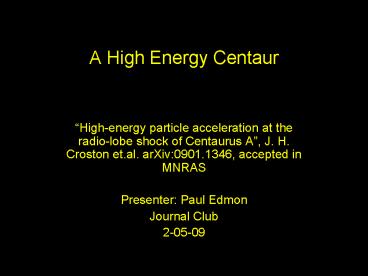A High Energy Centaur PowerPoint PPT Presentation
1 / 15
Title: A High Energy Centaur
1
A High Energy Centaur
- High-energy particle acceleration at the
radio-lobe shock of Centaurus A, J. H. Croston
et.al. arXiv0901.1346, accepted in MNRAS - Presenter Paul Edmon
- Journal Club
- 2-05-09
2
Outline
- Centaurus A
- Chandra Observations
- Spectral Fitting
- Dynamical Information
- Comparisons and Conclusions
3
Centaurus A
- Distance 3.7 Mpc
- Visual Magnitude 7.8
- Angular Scale 1 arcsec 17.9 pc
- A FRII Radio Galaxy
- One of the closest AGN to us
- Largest Jet Extent (not in picture) 600 kpc
- Possible Source of UHECR
- Auger anisotropy data has CR clustering around
Cen A - Scale of 600-kpc lobes consistent with scale
needed to produce UHECR (in a 1 µG field, E500
EeV)
Credit ESO/WFI (Optical), ESO/APEX/A.Weiss
et.al. (Sub-millimetre), Chandra/R. Kraft et.al.
(X-Ray)
4
Chandra Observations
- Compiled from 10 separate ACIS observations
- Time 507 ks
- Band 0.4 2.5 keV
- Resolution 2.3 arcsec
- VLA Contours at 1.4 GHz
- Combined archival data from several observing
different modes - Resolution 6.1 x 1.9
5
Regions for Spectral Fitting
- Spectra fitted using APEC (Astrophysical Plasma
Emission Code) with 5 different models - Model I Thermal Model with free abundance
- Model II Thermal Model with 0.15 Z?
- Model III Thermal Model with 0.5 Z?
- Model IV Single Power Law
- Model V Combination III and IV
6
Region 1 Spectral Fits
7
Table of Spectral Fits
8
Spectral Maps
- X-ray Spectral Index Map
- Red 0.5
- Blue 2.5
- Temperature Map
- Red 4.0 keV
- Yellow 0.7 keV
- Model V
- Has a large thermal component in the inner region
and a large nonthermal component in the rest of
the lobe
9
Broadband SED in Region 2
- X-Ray Spectral Index 1.0 (previous spectral
index of 2.0 quoted in units of
photons/cm2/s/keV) - Left a 0.5, ?break 4.4x104, ?max 5x109
- Right a 0.5, ?max 3x108
10
Dynamics
- Since Region 3 is Thermally Dominated we can
extract dynamical information - np 0.033 cm-3, nISM(beta model) 0.01 cm-3
- P 1.1x10-10 dyne/cm2, PISM 1.1x10-11 dyne/cm2
- M 2.8, v 850 km/s
- Using information from Region 3 we will try to
get information on Region 2 - np 0.004 cm-3, nISM(beta model) 0.001 cm-3
- Assuming that the lobe is isobaric P 1.1x10-10
dyne/cm2, PISM 1.3x10-12 dyne/cm2 - M 8.4, v 2600 km/s
11
More Dynamics
- From Equipartition B 8 µG
- Enthalpy 7x1056 ergs
- Using expansion speed midway along shell
1.2x1056 ergs - Assuming constant expansion the age is 2 Myr
- Mean jet power 1043 ergs/s
12
Comparisons and Other Facts
- Synchrotron-IC Lifetime for B 8 µG and ?
3x108 1.1 kyr - Expected Shell Thickness at 3.6 keV assuming a
post-shock velocity of 650 km/s 1 pc - Expected Shell Thickness at 0.4 keV 3 pc
- Hillas Criterion Maximum Energy 2 EeV
Credit Z. Levay
13
TeV Emission
- Left1µG, Right7µG
14
Conclusions
- The forward shock of the inner lobe of Cen A is
producing non-thermal synchrotron emission - Given a microGauss field strength this implies
particle acceleration up to at least TeV
energies, analogous to SN 1006 and other
non-thermal X-ray emitting SNRs - The shock in Cen A has analogous characteristics
to the forward shock of SN 1006 - TeV Gamma Ray Emission is predicted to be seen at
this source.
15
By Analogy
Credit HESS Collaboration

